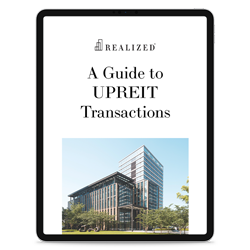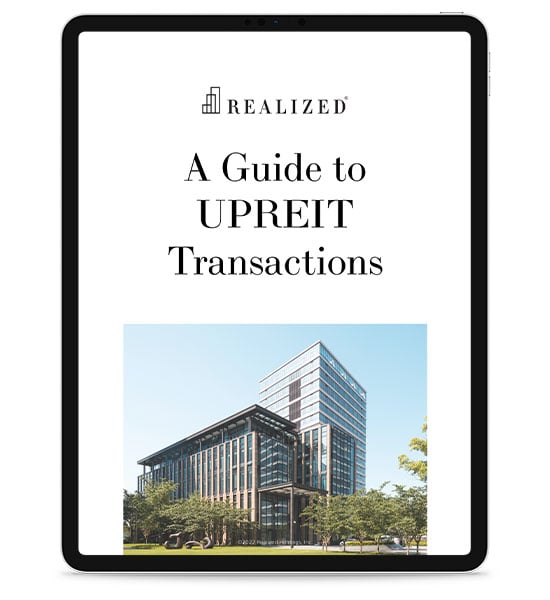
Umbrella partnership real estate investment trusts (UPREITs) come with a variety of benefits that make them highly appealing to certain types of investors. If you’ve been considering entering one as part of your long-term investment strategy, there are plenty of considerations to keep in mind, too.
One aspect that’s essential to understand is the step-by-step process of the UPREIT contribution. How does an UPREIT transaction work? What are the specific stages you need to follow to ensure a successful exchange? Below, Realized 1031 shares what you need to know.
Recap of UPREITs and Their Main Purpose
UPREITs are investment vehicles and legal entities structured as operating partnerships (OP). The UPREIT owns real estate assets, and the income generated from these properties is distributed to investors as dividends.
To enter an UPREIT, you need to contribute your properties in a process called a 721 exchange. You receive OP units equivalent to the value of the assets you gave up, and the IRS doesn’t recognize gains or losses during the contribution, which allows you to defer capital gains taxes while accessing new property types or sectors. This deferral is the primary benefit of the UPREIT, particularly for investors with highly appreciated properties.
The UPREIT Transaction Process
How do you contribute your real estate assets to an UPREIT and ensure that you enjoy tax deferral benefits?
1. Understand an UPREIT and Its Benefits
The first step is to research and gain an in-depth understanding of how UPREITs work. How do you earn? What level of control is allowed for investors? What are the exit strategies? Answering these questions helps you understand the key opportunities and challenges you may encounter with the UPREIT. This knowledge will also help you compare the strategy against similar options like 1031 exchanges and Delaware Statutory Trusts (DSTs). You’ll have far more confidence entering one knowing what to expect!
2. Engage With a REIT
In the operating partnership, the REIT has the controlling interest, so you’ll need to make contact with one to begin the process. While you can reach out directly, an easier path is working with a broker who has access to a vast network of REIT acquisition teams.
Once you’ve started communicating, REITs typically ask for the following information about the asset you want to contribute.
- Location and market context
- Current rental income and historical performance
- Tenant information, including lease terms and creditworthiness
- Physical condition of the property
3. Agree on the Deal Terms
If the REIT expresses interest in acquiring your property after its assessment, then the next step is to negotiate deal terms. Some key transaction points are the following.
- Property Valuation: How will the asset be valued? Some work with third-party appraisers, while others compare similar properties in the same market.
- OP Units: Based on the value of your property, how many OP units will you receive?
- Cash Component: You may also receive cash or debt relief alongside the OP units. However, this may be considered boot and is taxable.
- Closing Timeline: Discuss how you’ll contribute the property and the closing timeline.
4. Choose How You’ll Contribute
There are a few ways you can contribute your real estate asset to the UPREIT. The most straightforward way is to directly transfer the deed into the operating partnership. For properties owned by LLCs, you may need to transfer the LLC itself into the UPREIT. If you own only part of the property, special arrangements such as “tenancy-in-common roll-ups” may be used so multiple owners can participate. Whatever method you choose, professional guidance is critical because of the complex tax and legal requirements of this stage.
5. Paperwork and Review
REITs will conduct due diligence to ensure that the property has no issues. Key areas they will evaluate before starting the closing process include the title, tenant record, and leases. Afterward, you’ll need to sign paperwork such as the contribution agreement, which serves as the primary contract for the transaction. The partnership agreement is another important document that outlines your rights and obligations as a unit holder.
6. Closing
On closing day, the following steps happen.
- You transfer your property or entity into the REIT’s partnership.
- You receive OP units (and any agreed-upon cash).
- The REIT may assume your existing mortgage or arrange refinancing.
The closing marks your official entry into the REIT’s diversified portfolio.
7. After Closing
You will begin receiving dividends from the UPREIT after the closing. You may need to wait for at least one year (depending on the partnership agreement holding period) before you can begin converting your OP units to REIT shares. While this particular process helps you liquidate your cash, it’s a taxable event. Beyond the income potential, you now own a share of a larger, professionally managed portfolio, free from the demands of direct property management.
Tips for a Better Chance of Success
Here are some best practices you can follow to streamline the entire UPREIT process and increase the chance of success.
- Engage with Professionals: While the transaction seems straightforward, there are plenty of nuances and complexities that will require professional guidance. Working with tax advisors and REIT professionals helps ensure that you’re following the right steps.
- Prepare Detailed Property Documentation: Clean and comprehensive records allow for a more streamlined contribution process.
- Discuss Your Options Beyond Valuation: The number of OP units you receive is not the end of the conversation. Negotiate with your REIT regarding matters like distribution frequency or special liquidity provisions. This way, you can address concerns as early as possible.
Wrapping Up: How the UPREIT Process Happens
Contributing your real estate assets during a 721 exchange is fairly straightforward. From the initial communication to the actual contribution and closing, the transaction is akin to a traditional real estate sale, albeit with a few complexities and provisions. Following the steps we outlined above, with the guidance of a tax professional, can help you ensure tax-deferral benefits and increase the chances of maximum ROI.
Sources:
https://www.investopedia.com/terms/b/boot.asp



